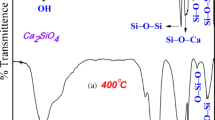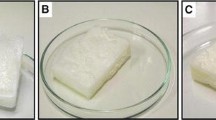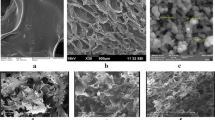Abstract
Gelatin was extracted from 3 (body, foot, and viscera) different body parts of Ficus variegata using an alkaline treatment. Composite scaffolds were prepared for tissue engineering applications. Proximate analysis of F. variegata prior to extraction showed percentage values of 16.67–14.33% for protein, 74.53–72.72% for moisture, 3.63–2% for ash, and 2.33–0.33% for lipids. Extracted gelatin was characterized using Fourier transform infrared (FTIR), SDS-PAGE, and amino acid analysis. Composite scaffolds using alkali treated gelatin of all 3 body parts with 4 different commercial cross-linkers [chitosan, hydroxy apatite (HA), glutaraldehyde, and nano hydroxy apatite (nHA)] were prepared and structural morphology and porosity were analyzed using scanning electron microscopy (SEM). The nHA blended gelatin scaffolds had a pore size ranging 1–10 μm. The swelling ratio, in vitro degradation, and the protein adsorption capacity was observed to be high in chitosan blended gelatin scaffolds.
Similar content being viewed by others
References
Sakr AH. A Muslim Guide to Food Ingredients. 6th ed. Foundation for Islamic Knowledge, Walnut, CA, USA. p. 187 (1997)
Oakenfull D, Scott A. Gelatin gels in deuterium oxide. Food Hydrocolloid. 17: 207–210 (2003)
Johnston-Banks FA. Gelatin. pp. 233–289. In: Food Gels. Harris P (ed). Elsevier Applied Science, London, UK (1990)
Stevens PV. Trace bioorganic constituents of gelatins-review. Food Australia 44: 320–324 (1992)
Hinterwaldner R. Raw materials. pp. 295–314. In: The Science and Technology of Gelatin. Ward AG, Courts A (eds). Academic Press, London, UK (1977)
GME. Gelatin manufacturers of Europe. Available from: http://www.gelatine.org/en/gelatin/overview/127.html. Accessed Mar. 15, 2008.
Karim AA, Bhat R. Fish gelatin: Properties, challenges, and prospects as an alternative to mammalian gelatins. Food Hydrocolloid. 23: 563–576 (2009)
Sadowska M, Kolodziejska I, Niecikowska C. Isolation of collagen from the skins of Baltic cod (Gadus morhua). Food Chem. 81: 257–262 (2003)
Kristinsson HG, Rasco BA. Biochemical and functional properties of Atlantic salmon (Salmo salar) muscle hydrolyzed with various alkaline proteases. J. Agr. Food Chem. 48: 657–666 (2000)
AOAC. Official Methods of Analysis of AOAC Intl. 12th ed. Method 984.13, 920.39, 942.05. Association of Official Analytical Chemists, Washington, DC, USA (1975)
KoŁodziejska I, Skierka E, Sadowska M, Kołodziejski W, Niecikowska C. Effect of extracting time and temperature on yield of gelatin from different fish offal. Food Chem. 107: 700–706 (2008)
Lowry OH, Rose brough NJ, Farr L, Randall RJ. Protein measurement with the Folin phenol reagent. J. Biol. Chem. 193: 267–275 (1951)
Yang H, Wang Y, Jiang M, Oh JH, Herring J, Zhou P. Optimization of extraction and physical properties of channel catfish (Ictalurus punctatus) skin gelatine. J. Food Sci. 72: C188–C195 (2007)
Cho SH, Jahncke, ML, Eun JB. Nutritional composition and microflora of the fresh and fermented skate (Raja kenojei) skins. Int. J. Food Sci. Nutr. 55: 45–51 (2004)
Laemmli UK. Cleavage of structural proteins during the assembly of the head of bacteriophage T4. Nature 227: 680–685 (1970)
Aewsiri T, Benjakul S, Visessanguan W, Wierenga PA, Gruppen H. Antioxidative activity and emulsifying properties of cuttlefish skin gelatine-tannic acid complex as influenced by types of interaction. Innov. Food Sci. Emerg. 694: 1–9 (2010)
Irwandi J, Faridayanti S, Mohamed ESM, Hamzah MS, Torla HH, Cheman YB. Extraction and characterization of gelatin from different marine fish species in malaysia. Int. Food Res. J. 16: 381–389 (2009)
Han JK, Song HY, Saito F, Lee BT. Synthesis of high purity nanosized hydroxyapatite powder by microwave-hydrothermal method. Mater. Chem. Phys. 99: 235–239 (2006)
Peter M, Ganesh N, Selvamurugan N, Nair SV, Furuike T, Tamura H, Jayakumar R. Preparation and characterization of chitosangelatin/nanohydroxyapatite composite scaffolds for tissue engineering applications. Carbohyd. Polym. 80: 687–694 (2010)
Nazeer RA, Srividhya TS. Antioxidant peptides from the Protein Hydrolysates of Conus betulinus. Int. J. Pept. Res. Ther. 17: 231–237 (2011)
Jamilah B, Harvinder KG. Properties of gelatins from skins of fishblack tilapia (Oreochromis mossambicus) and red tilapia (Oreochromis nilotica). Food Chem. 77: 81–84 (2002)
Zhou P, Regenstein JM. Effects of alkaline and acid pretreatments on Alaska pollock skin gelatin extraction. J. Food Sci. 70: 392–396 (2005)
Djabourov M, Lechaire JP, Gaill F. Structure and rheology of gelatin and collagen gels. Biorheology 30: 191–205 (1993)
Halling PJ. Protein stabilized foams and emulsions. CRC Cr. Rev. Food Sci. 12: 155–203 (1981)
Townsend AA, Nakai S. Relationships between hydrophobicity and foaming characteristics of food proteins. J. Food Sci. 48: 588–593 (1983)
Van der Ven C, Gruppen H, de Bont DBA, Voragen AGJ. Correlations between biochemical characteristics and foam-forming and -stabilizing ability of whey and casein hydrolysates. J. Agr. Food Chem. 50: 2938–2946 (2002)
Mutilangi WAM, Panyam D, Kilara A. Functional properties of hydrolysates from proteolysis of heat-denatured whey protein isolate. J. Food Sci. 61: 270–274 (1996)
Gomez-Guillen MC, Turnay J, Fernandez-Diaz MD, Ulmo N, Lizarbe M, Montero P. Structural and physical properties of gelatin extracted from different marine species: A comparative study. Food Hydrocolloid. 16: 25–34 (2002)
Gomez-Guillen MC, Gimenez B, Montero P. Extraction of gelatine from fish skins by high pressure treatment. Food Hydrocolloid. 19: 923–928 (2005)
Carvalho RA, Sobral PJA, Thomazine M, Habitante AMQB, Gimenez B, Gomez-Guillen MC, Montero P. Development of edible films based on differently processed Atlantic halibut (Hippoglossus hippoglossus) skin gelatin. Food Hydrocolloid. 22: 1117–1123 (2008)
Nalinanon S, Benjakul S, Visessanguan W, Kishimura H. Improvement of gelatine extraction from bigeye snapper skin using pepsin-aided process in combination with protease inhibitor. Food Hydrocolloid. 22: 615–622 (2008)
Payne KJ, Veis A. Fourier transform IR spectroscopy of collagen and gelatine solutions: Deconvolution of amide I band for conformational studies. Biopolymers 27: 1749–1760 (1988)
Muyonga JH, Cole CGB, Duodu KG. Fourier transform infrared (FTIR) spectroscopic study of acid soluble collagen and gelatin from skins and bones of young and adult Nile perch (Lates niloticus). Food Chem. 86: 325–332 (2004)
Wong DWS. Mechanism and Theory in Food Chemistry. Van Nostrand Reinhold Company Inc., New York, NY, USA (1989)
Bhat R, Karim AA. Ultraviolet irradiation improves gel strength of fish gelatine. Food Chem. 113: 1160–1164 (2009)
Foegeding EA, Lanier TC, Hultin HO. Food chemistry. pp. 879–942. In: Characteristics of Edible Muscle Tissues. Fennema OR (ed). MarcelDekker Inc., New York, NY, USA (1996)
Aewsiri T, Benjakul S, Visessanguan W, Tanaka M. Chemical compositions and functional properties of gelatin from pre-cooked tuna fin. Int. J. Food Sci. Tech. 43: 685–693 (2008)
Ledward DA. Gelation of gelatin. pp. 171–201. In: Functional Properties of Food Macromolecules. Mitchell JR, Ledward DA (eds). Elsevier Applied Science, London, UK 1986)
Arnesen JA, Gildberg A. Extraction and characterisation of gelatine from Atlantic salmon (Salmo salar) skin. Bioresource Technol. 98: 53–57 (2007)
Karageorgiou V, Kaplan D. Porosity of 3D biomaterial scaffolds and osteogenesis. Biomaterials 26: 5474–5491 (2005)
Kim HW, Kim HE, Salih V. Stimulation of osteoblast responses to biomimetic nanocomposites of gelatin-hydroxyapatite for tissue engineering scaffolds. Biomaterials 26: 5221–5230 (2005)
Kim HW, Knowles JC, Kim HE. Porous scaffolds of gelatin-hydroxyapatite nanocomposites obtained by biomimetic approach: Characterization and antibiotic drug release. J. Biomed. Mater. Res. B 74: 686–698 (2005)
Zheng JP, Wang CZ, Wang XX, Wang HY, Zhuang H, Yao KD. Preparation of biomimetic three-dimensional gelatin/montmorillonite — chitosan scaffold for tissue engineering. React. Funct. Polym. 67: 780–788 (2007)
Thein HWW, Misra RDK. Biomimetic chitosan-nanohydroxyapatite composite scaffolds for bone tissue engineering. Acta Biomater. 5: 1182–1197 (2009)
Nordtveit RJ, Varum KM, Smidsrod O. Degradation of partially Nacetylated chitosans with hen egg white and human lysozyme. Carbohyd. Polym. 29: 163–167 (1996)
Kilpadi KL, Chang PL, Bellis SL. Hydroxyapatite binds more serum proteins, purified integrins, and osteoblast precursor cells than titanium or steel. J. Biomed. Mater. Res. B 57: 258–267 (2001)
Chou L, Marek B, Wagner WR. Effects of hydroxylapatite coatingcrystallinity on biosolubility, cell attachment efficiency and proliferation in vitro. Biomaterials 20: 977–985 (1999)
Sawyer AA, Hennessy KM, Bellisa SL. Regulation of mesenchymal stem cell attachment and spreading on hydroxyapatite by RGD peptides and adsorbed serum proteins. Biomaterials 26: 1467–1475 (2005)
Linez-Bataillon P, Monchau F, Bigerelle M, Hildebrand HF. In vitro MC3T3 osteoblast adhesion with respect to surface roughness of Ti6Al4V substrates. Biomol. Eng. 19: 133–141 (2002)
Author information
Authors and Affiliations
Corresponding author
Rights and permissions
About this article
Cite this article
Nazeer, R.A., Sri Suganya, U. Porous scaffolds of gelatin from the marine gastropod Ficus variegate with commercial cross linkers for biomedical applications. Food Sci Biotechnol 23, 327–335 (2014). https://doi.org/10.1007/s10068-014-0046-z
Received:
Revised:
Accepted:
Published:
Issue Date:
DOI: https://doi.org/10.1007/s10068-014-0046-z




